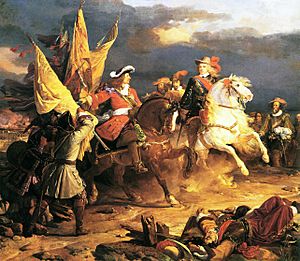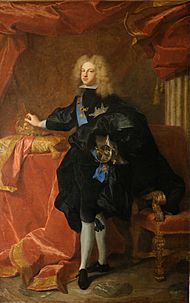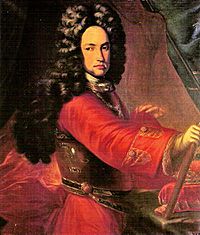Battle of Villaviciosa facts for kids
Quick facts for kids Battle of Villaviciosa |
|||||||
|---|---|---|---|---|---|---|---|
| Part of the War of the Spanish Succession | |||||||
 Vendôme (left) presents the standards to Philip V of Spain (right) at Villaviciosa by Jean Alaux. |
|||||||
|
|||||||
| Belligerents | |||||||
| Commanders and leaders | |||||||
| Strength | |||||||
| 20,000 | 14,000 | ||||||
| Casualties and losses | |||||||
| 2,000–3,000 dead or wounded |
5,000–6,000 dead or wounded 3,000 captured |
||||||
The Battle of Villaviciosa was an important fight during the War of the Spanish Succession. It happened on December 11, 1710, in Spain. This battle was between two main groups. One side was the Franco-Spanish army, led by Duke of Vendôme and Philip V of Spain, who was the King of Spain. The other side was an army allied with the Habsburgs, led by the Austrian general Guido Starhemberg.
The battle took place just one day after the Franco-Spanish army won a victory at Brihuega. At Brihuega, they defeated a British army. Both King Philip V and Archduke Charles of Austria claimed they won the Battle of Villaviciosa. However, looking at the number of soldiers lost, the weapons left behind, and what happened next in the war, it was clear that King Philip V's side had truly won.
A key part of the battle was the Spanish dragoons. These were soldiers who rode horses but could also fight on foot. They were led by the Marquis of Valdecañas and the Count of Aguilar. Their forces were much stronger than the enemy's. After the battle, the Austrian forces had to retreat. They were chased by Spanish cavalry. By the time they reached Barcelona, their army was much smaller, with only about 6,000 to 7,000 men left. Barcelona was one of the few places in Spain that still supported Archduke Charles.
Contents
What Happened Before the Battle?
The War for the Spanish Throne
The War of the Spanish Succession was a big conflict in Europe. It was fought to decide who would be the next king of Spain. Two main people wanted the throne: Philip V, who was supported by France, and Archduke Charles of Austria, who was supported by countries like Britain, the Netherlands, and Portugal.
Allied Victories and Retreat
In 1710, Archduke Charles's allies won two battles: the Battle of Almenara on July 27 and the Battle of Saragossa on August 20. These wins allowed them to capture Madrid, the capital of Spain, for the second time. Archduke Charles entered Madrid on September 21.
However, holding Madrid was difficult for the allied army. Their army, which started with 23,000 soldiers, had become smaller due to the previous battles and small fights with Spanish-Bourbon soldiers. They couldn't stay in Madrid for long.
The Retreat to Catalonia
On November 9, the allied army left Madrid. They began to retreat towards Catalonia, a region in northeastern Spain. Spanish cavalry, led by the Marquis of Valdecañas, followed them closely. Archduke Charles left the main army with 2,000 cavalry soldiers and quickly went back to Barcelona.
The rest of the allied army marched in two separate groups. General Starhemberg led the main group of 12,000 men. About a day's march behind him were 5,000 British troops, led by Lord Stanhope.
The Battle of Brihuega
On December 9, 1710, the British force under Lord Stanhope was surprised and defeated at Brihuega. The British soldiers, including Stanhope, were taken prisoner.
When General Starhemberg heard about the attack on the British, he moved his troops to help. But he didn't know that Stanhope's army had already surrendered.
Armies Meet at Villaviciosa
The next morning, December 10, the Franco-Spanish army was waiting on the plain of Villaviciosa. General Starhemberg had about 14,000 soldiers. The Duke of Vendôme had about 20,000 men, including King Philip V himself, who had joined the Duke that morning. Both armies lined up in two rows, which was common for battles at that time. They stood on parallel ridges, ready to fight.
How the Armies Were Set Up
Bourbon Army's First Line
The Bourbon army, supporting King Philip V, had two main lines of soldiers.
Right Wing
- Commander: Marquis of Valdecañas.
- King Philip V himself was with the cavalry here.
- This wing had several groups of cavalry called Dragoons (like Caylus, Vallejo, Osuna) and other cavalry units.
Center
- Commander: Count of Torres.
- This part of the army had many infantry battalions (foot soldiers).
- These included Spanish Guards, Walloon Guards, and other regiments like Comesfort and Castellar.
Left Wing
- Commander: Count of Aguilar.
- The future Duke of Montemar fought here as a field marshal.
- This wing also had several cavalry squadrons, including Dragoons of Marimon and Reina.
Bourbon Army's Second Line
This line provided support and backup for the first line.
Right Wing
- Commander: Count of Merode, who worked under the Marquis of Valdecañas.
- It included cavalry squadrons like Asturias, Muerte, and Pozoblanco.
Center
- Commander: Lieutenant-General Pedro de Zúñiga.
- This section had more infantry battalions, such as Castile, Murcia, and Savoy.
Left Wing
- Commander: Lieutenant-General Navamorquende, under the Count of Aguilar.
- It had cavalry squadrons like New Roussillon and Old Roussillon.
Artillery
- Commander: Marquis of Canales.
- The Bourbon army had 23 cannons.
The Battle Begins
The battle started in the afternoon and lasted until midnight. Both armies had 23 cannons, set up in three groups. The cannon fire began at the same time, causing damage to both sides.
Bourbon Right Wing Attacks
The Marquis de Valdecañas, leading the cavalry on the Bourbon right wing (where King Philip was), started the main attack. Valdecañas sent his cavalry against the allied left wing. This part of the allied army was made up of German foot soldiers and Portuguese and Spanish cavalry. Imperial General von Frankenberg commanded them.
The German infantry and Portuguese cavalry tried to stop the Bourbon charge. But they couldn't hold their ground, and the allied left wing was destroyed. The Spanish captured their cannons. Anglo-Dutch troops sent to help the allied left wing were also defeated.
Allied Center Pushes Back
With the allied left wing beaten, Archduke Charles's infantry moved forward against the Franco-Spanish center. They pushed back the Bourbon foot soldiers. The Marquis of Toy tried to prevent his men from being captured and keep the army together. However, most of his soldiers were taken prisoner by the Portuguese.
Bourbon Left Wing's Counterattack
Even though the Bourbons in the center were in trouble, the Count of Aguilar led his cavalry against Archduke Charles's right wing. This part of the allied army was very strong. It had the best grenadiers (specialized soldiers) and cavalry squadrons.
The allies could not stop the Count of Aguilar's cavalry. The Archduke's right wing was saved from total defeat by help from the center, led by the Spanish general Villarroel. General Starhemberg gathered his forces again. He pushed back the Count of Aguilar's cavalry and then attacked the Bourbon left wing. After capturing the cannons on the Bourbon left wing, Starhemberg sent his army against the center.
Bourbon Retreat and Final Push
The Bourbon center and left wing began to retreat. Meanwhile, the Bourbon right-wing cavalry continued to chase the defeated allied left wing. The Count of Aguilar then attacked Archduke Charles's right wing again with his dragoons. Even though the German and Portuguese cavalry fought hard, Aguilar's cavalry broke through the allied right wing.
Valdecañas's cavalry also struck a severe blow to the allied army. Lieutenant General Mahony and Field Marshal Amezaga's troops charged from the right wing. In response, Starhemberg launched three cavalry charges against them. During the intense fighting, Amezaga was wounded in the face.
Starhemberg's forces retreated into a nearby forest to escape the Franco-Spanish cavalry. As night fell, the allied forces began to withdraw. The British regiments suffered heavy losses. Brigadier-General Lepell, the highest-ranking British officer, reported that two regiments had been cut off. He also said that over 107 men were missing from his own unit, and he had only two cavalry squadrons left.
What Was the Outcome?
Both King Philip V of Spain and Archduke Charles claimed they won the Battle of Villaviciosa. However, the facts showed a clear victory for Philip V. The number of soldiers killed or wounded, the weapons and cannons left behind by the allied army, and the overall impact on the war all confirmed that the French and Spanish had won.
General Starhemberg continued his retreat, with Spanish cavalry constantly bothering his army. By the time he reached Barcelona, his army was much smaller, with only about 6,000 to 7,000 men remaining.
The Spanish throne was finally secured for Philip V. This happened when Archduke Charles left Spain in April 1711. He left because his older brother had died, and Charles was going to become the new Holy Roman Emperor. With Charles gone, Philip V's claim to the Spanish throne was much stronger.
Images for kids
See also
 In Spanish: Batalla de Villaviciosa (1710) para niños
In Spanish: Batalla de Villaviciosa (1710) para niños






